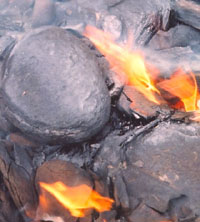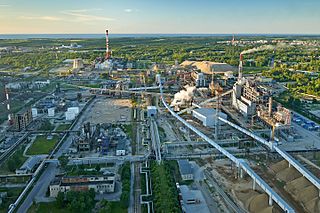
Oil shale is an organic-rich fine-grained sedimentary rock containing kerogen from which liquid hydrocarbons can be produced, called shale oil. Shale oil is a substitute for conventional crude oil; however, extracting shale oil is costlier than the production of conventional crude oil both financially and in terms of its environmental impact. Deposits of oil shale occur around the world, including major deposits in the United States. A 2016 estimate of global deposits set the total world resources of oil shale equivalent of 6.05 trillion barrels of oil in place.
Kerogen is solid, insoluble organic matter in sedimentary rocks. Comprising an estimated 1016 tons of carbon, it is the most abundant source of organic compounds on earth, exceeding the total organic content of living matter 10,000-fold. It is insoluble in normal organic solvents and it does not have a specific chemical formula. Upon heating, kerogen converts in part to liquid and gaseous hydrocarbons. Petroleum and natural gas form from kerogen. Kerogen may be classified by its origin: lacustrine (e.g., algal), marine (e.g., planktonic), and terrestrial (e.g., pollen and spores). The name "kerogen" was introduced by the Scottish organic chemist Alexander Crum Brown in 1906, derived from the Greek for "wax birth" (Greek: κηρός "wax" and -gen, γένεση "birth").
Unconventional oil is petroleum produced or extracted using techniques other than the conventional method. Industry and governments across the globe are investing in unconventional oil sources due to the increasing scarcity of conventional oil reserves. Unconventional oil and gas have already made a dent in international energy linkages by reducing US energy import dependency.
Shale oil is an unconventional oil produced from oil shale rock fragments by pyrolysis, hydrogenation, or thermal dissolution. These processes convert the organic matter within the rock (kerogen) into synthetic oil and gas. The resulting oil can be used immediately as a fuel or upgraded to meet refinery feedstock specifications by adding hydrogen and removing impurities such as sulfur and nitrogen. The refined products can be used for the same purposes as those derived from crude oil.

The Shell in situ conversion process is an in situ shale oil extraction technology to convert kerogen in oil shale to shale oil. It is developed by the Shell Oil Company.

The oil shale industry is an industry of mining and processing of oil shale—a fine-grained sedimentary rock, containing significant amounts of kerogen, from which liquid hydrocarbons can be manufactured. The industry has developed in Brazil, China, Estonia and to some extent in Germany and Russia. Several other countries are currently conducting research on their oil shale reserves and production methods to improve efficiency and recovery. Estonia accounted for about 70% of the world's oil shale production in a study published in 2005.

Shale oil extraction is an industrial process for unconventional oil production. This process converts kerogen in oil shale into shale oil by pyrolysis, hydrogenation, or thermal dissolution. The resultant shale oil is used as fuel oil or upgraded to meet refinery feedstock specifications by adding hydrogen and removing sulfur and nitrogen impurities.

Environmental impact of the oil shale industry includes the consideration of issues such as land use, waste management, and water and air pollution caused by the extraction and processing of oil shale. Surface mining of oil shale deposits causes the usual environmental impacts of open-pit mining. In addition, the combustion and thermal processing generate waste material, which must be disposed of, and harmful atmospheric emissions, including carbon dioxide, a major greenhouse gas. Experimental in-situ conversion processes and carbon capture and storage technologies may reduce some of these concerns in future, but may raise others, such as the pollution of groundwater.

The history of the oil shale industry started in ancient times. The modern industrial use of oil shale for oil extraction dates to the mid-19th century and started growing just before World War I because of the mass production of automobiles and trucks and the supposed shortage of gasoline for transportation needs. Between the World Wars oil shale projects were begun in several countries.
Oil shale gas is a synthetic non-condensable gas mixture (syngas) produced by oil shale thermal processing (pyrolysis). Although often referred to as shale gas, it differs from the natural gas produced from shale, which is also known as shale gas.
The American Shale Oil, LLC (AMSO), originally known as EGL Oil Shale, LLC, was a developer of in-situ shale oil extraction technology based in Rifle, Colorado. It was owned by Genie Energy and Total S.A.. In May 2016, Genie Energy announced that the AMSO project was closing.
Independent Energy Partners, Inc. (IEP) is an oil shale resources company based in Parker, Colorado, the United States. It is a developer of the Geothermic Fuels Cells Process, an in-situ shale oil extraction process. CEO of the company is Alan K. Forbes.
Mountain West Energy, LLC is an American unconventional oil recovery technology research and development company based in Orem, Utah. It is a developer of the In-situ Vapor Extraction Technology, an in-situ shale oil extraction technology. The company owns 880 acres (3.6 km2) oil shale leases in the Uintah Basin, Uintah County, Utah.
The TOSCO II process is an above ground retorting technology for shale oil extraction, which uses fine particles of oil shale that are heated in a rotating kiln. The particularity of this process is that it use hot ceramic balls for the heat transfer between the retort and a heater. The process was tested in a 40 tonnes per hour test facility near Parachute, Colorado.
ExxonMobil Electrofrac is an in situ shale oil extraction technology proposed by ExxonMobil for converting kerogen in oil shale to shale oil.
The Paraho process is an above ground retorting technology for shale oil extraction. The name "Paraho" is delivered from the words "para homem", which means in Portuguese "for mankind".
The Lurgi–Ruhrgas process is an above-ground coal liquefaction and shale oil extraction technology. It is classified as a hot recycled solids technology.
Omnishale process is an in situ shale oil extraction technology to convert kerogen in oil shale to shale oil. This process is classified as an externally generated hot gas technology. The technology is developed by General Synfuels International, a subsidiary of Earth Search Sciences.
The LLNL RISE process was an experimental shale oil extraction technology developed by the Lawrence Livermore National Laboratory. The name comes from the abbreviation of the Lawrence Livermore National Laboratory and words 'rubble in situ extraction'.
The history of the oil shale industry in the United States goes back to the 1850s; it dates back farther as a major enterprise than the petroleum industry. But although the United States contains the world's largest known resource of oil shale, the US has not been a significant producer of shale oil since 1861. There were three major past attempts to establish an American oil shale industry: the 1850s; in the years during and after World War I; and in the 1970s and early 1980s. Each time, the oil shale industry failed because of competition from cheaper petroleum.





